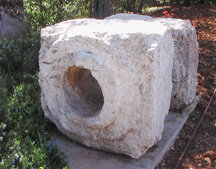Template:Stoneaqueductpic
Jump to navigation
Jump to search

Pontius Pilate's appropriation of funds from the holy treasury to build an aqueduct[2] stirred up a coordinated protest in Jerusalem and possibly at the tower of Siloam, which was likely used to guard the spring, protecting and controlling water flow into the aqueduct.[3]
Pilate discovered the plot and set soldiers in plain clothes among them in Jerusalem. The protest turned into a riotous rebellion in which men died.[4]
When some militant Zealots simultaneously occupied the tower of Siloam, Pilate would have also sent troops to seize the tower which got eighteen men killed. Some believe Barabbas was arrested because of these seditious events. The cross was reserved for rebels who would seek to overthrow the government. Luke 13 is talking about the protestors' rebellion against the misuse of the Corban funds.
- ↑ The Greek word korban is related to the term korbanas, signifying the “temple treasury.” Korbanas'(or κορβανᾶς)': among the Jews the holy treasury.
- ↑ It brought in water from a distance of seventy-two kilometers.
- ↑ "From the Suda or Souda a tenth-century Byzantine encyclopedia of the ancient Mediterranean, which uses ancient sources that have since been lost.
- ↑ "At another time he used the sacred treasure of the temple, called corban (qorban), to pay for bringing water into Jerusalem by an aqueduct. A crowd came together and clamored against him; but he had caused soldiers dressed as civilians to mingle with the multitude, and at a given signal they fell upon the rioters and beat them so severely with staves that the riot was quelled." The Aqueduct- Josephus, War 2.175-177, Antiq 18.60-62.